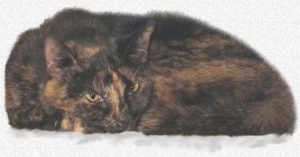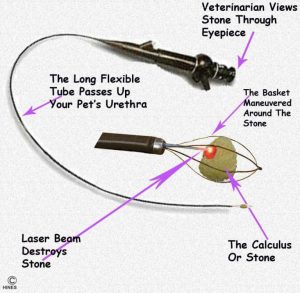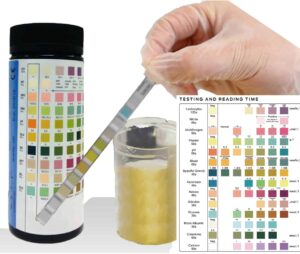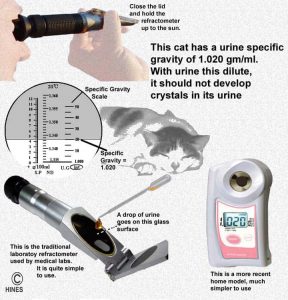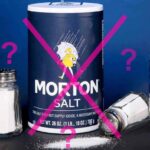All About Oxalate Bladder And Kidney Stones In Your Cat
How To Manage Them (Cystic and renal calculi)
Ron Hines DVM PhD
 If struvite crystals might be your cat’s problem?
If struvite crystals might be your cat’s problem?
What Is Oxalate And Why Has It Formed Urinary Stones In My Cat?
The chemistry of oxalates make them one of the most frustrating health problem that veterinarians and pet-owners deal with.
Oxalic acid is an organic acid produced in animals and plants when, sugars and other carbohydrates and carbon sources are metabolized. Oxalic acid does not circulate free in the body; it links to sodium or potassium in a soluble oxalate-salt form. But when oxalic acid finds itself in the presence of calcium, it has the ability to links to it too, forming a particular insoluble salt crystal – calcium oxalate. Your body and your pet’s body obtain oxalates in two ways, some of it is absorb from your diet and some of it you manufacture in your own body (primarily in the liver). In humans, about 20-50% is thought to come from diet and the rest to be manufactured “in house”, in cats that percentage is unknown. Oxalates do not appear to have any necessary function in the body; they are just a metabolic end-product destined to leave the body through urine – much like urea.
A distinctive property of oxalic acid that makes it so dangerous is that once it has linked with calcium, it is practically insoluble (will not dissolve) at the acidities normally found within the body. That one unusual characteristic of calcium oxalate (that nothing will dissolve it) is what makes it such an exasperating problem in veterinary and human medicine.
Why Did My Cat Form Calcium Oxalate Stones In It Bladder And Kidneys?
A small amount of calcium oxalate is present in all urine. It is only when it is present in abnormally high amounts or when the total composition of the urine (crystallization kinetics) favor the layered growth of these crystals into sizable stones that they become a medical problem. These kinetics are though to be a complicated variety of urine factors that favor crystal growth or inhibit crystal growth (eg nephrocalcin). They are not well understood in pets or humans. read here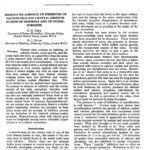 We do know that the urine of cats that form calcium oxalate stones tends to be highly acidic. (When a liquid is acidic, its pH is under 7) During the last 30 years, pet food companies formulated their diets to produce more acidic cat urine. That was in an attempt to prevent struvite urinary tract problems. However, acidic urine is conducive to oxalate stone formation. Some veterinarians believe that that accounts for the increased frequency of oxalate stones that we now see.
We do know that the urine of cats that form calcium oxalate stones tends to be highly acidic. (When a liquid is acidic, its pH is under 7) During the last 30 years, pet food companies formulated their diets to produce more acidic cat urine. That was in an attempt to prevent struvite urinary tract problems. However, acidic urine is conducive to oxalate stone formation. Some veterinarians believe that that accounts for the increased frequency of oxalate stones that we now see.
When two or more cats live in the same household and eat the same traditional canine diet, it is unlikely that more than one will develop an oxalate stone problem. Veterinarians and human urologists have pondered over why this is. They have written countless scientific articles on the subject but have never been able to tell you more than the cause is probably a combination of many individual things (multifactorial) things occurring in the affected pet’s or human’s body. Their advice continues to be “make as many changes in your pets nutrition and lifestyle that might (theoretically) slow oxalate crystal formation. Despite following that advice, some cats will go on to reform oxalate urinary tract stones and some will not. And some pets that made no changes in their lifestyle whatsoever will never have a relapse of the problem again. Anyone who tells you more than that is not basing the statements on what we currently know.
As with any disease, there are probably genetic traits that make one cat more susceptible to oxalate stones than another. But genetics cannot account for the greatly increased number of oxalate-affected pets veterinarians have seen in cats since 1981. Only lifestyle or nutritional factors could account for that.
What Signs Might I See If My Cat Has Oxalate Stones?
The majority of cats still develop oxalate stones in their lower urinary tract (bladder) not in their kidneys. However, the number of cats that develop the more dangerous type, higher in their tract (their kidneys), has increased 10-fold in the 20 years preceding 2000. (read here)
The most common sign owners notice is difficulty urinating. Cats spend more time in the litter box. They take longer to urinate and attempt to urinate more frequently. The amount of urine they pass with each voiding is often less. Sometimes the squat without success. Some cats spend excess time licking their genital area subsequent to urination. When you see this behavior, your cat has some form of urinary tract problem – oxalates are only one of many possibilities. If a small stone should find its way out of the bladder and lodge in your cat’s urethra, the problem becomes an emergency .
Owners might notice that the final drops of their cat’s urine are pink rather than its normal yellow although most cat liters make that difficult. At this stage, a few cats show physical distress or colicky signs, but most do not.
The next most common way these stones are discovered is when a cat is x-rayed – perhaps for an entirely different problem.
When stones are located in your cats kidneys, the physical signs can be less specific. They might include vague abdominal discomfort, colic, flank pain or weight loss.
The signs will be severe if a stone has moved from your pet’s kidney and lodged in one of its ureters.When oxalate stones are present in a pet’s kidneys for long periods without signs or unnoticed, the cat may come to the veterinarian already in uremia, due to the damage the stones have already caused to its kidneys.
None of these symptoms are specific to oxalate kidney or bladder stones – other types of urinary tract stones and abnormalities and infections of the kidneys, bladder or tubes that link them (ureters and urethra) will cause identical signs. Cats, with repeat urinary tract infections should be scrutinized particularly closely for the presence of urinary tract stones.
The Changing Dynamics Of Urinary Tract Stones In Cats (calculi)
Since 1981, the veterinary college at the University of Minnesota has been home to the University of Minnesota Urolith Center. Many urinary tract stones that develop in pets are analyzed and identified at this facility. They are submitted by veterinarians around the World. Since the service began, the number of stones that are found to be composed of oxalates has steadily increased. In 1981, approximately 2% of the stones were composed of oxalate. But by 2007, 41% were. Concurrently, the number of the common urinary tract stones that are composed of struvite (magnesium ammonium phosphate) has dropped. Struvite, not calcium oxalate, is still the most common constituent of the urethral plugs that plague some male cats (FUS). This is not occurring just here in the United States. The situation in Northwestern Europe is similar. (read here) Australian and New Zealand cats seem to have more than their share of oxalate crystal problems as well. Curiously, these same urinary oxalate increases seem to be occurring in humans. (read here) My suspicion is that a sedentary lifestyle increases the risk.
A Canadian studies did not find an increase in the frequency of calcium oxalate stones in the general cat population between 1998 and 2008. But the frequency of oxalate stones did increase in specific breeds of cats: Himalayan, Persian and Siamese breeds (particularly males). Some ragdoll cats, a highly inbred cat breed, appear to have a unique genetic susceptibility. (read here)
Is One Sex Of Cat More Susceptible To Oxalate Stones Than Another?
Both male and female cats are susceptible to oxalate stones – but somewhat more appear to occur in male cats. The appearance of more male cats with the problem at veterinary hospitals could just be because blocking urinary tract stones are much more likely to lodge on their way down a male urinary tract than they are in females (females have a wider and shorter urethra). More cases occur in midlife (5-9 years), rather than in younger or very old cats. Those older cats also tend to have more acidic urine that encourages oxalate stone formation.
How Will My Veterinarian Determine If My Cat Has An Oxalate Stone Problem?
Your Veterinarian’s Physical Examination
The history you give your veterinarian may already cause him/her to suspect that your pet’s problem involves its urinary system. Over their careers, veterinarians become very deft at probing and palpating the tummies of pets. They can feel many things through the walls of your pet’s abdomen that might not be apparent to you. Some cats are much easier to palpate (feel) than others. fat cats, large cats, anxious cats and cats that are tensing their abdomens due to pain (splinting) are harder to palpate. Your veterinarian might notice that your pet is tensing its abdomen due to pain and that the area of its kidneys might appear to be the most painful.
Your veterinarian will be able to palpate your pet’s bladder. When bladders are chronically inflamed by stones or infection, they become thicker than normal. If a large stone(s) is located in your pet’s bladder and the pet is relaxed enough, that stone should be palpable to your vet. When several stones are loose in the bladder, they often grind during palpation – similar to a handful of marbles.
In lean cats, the kidneys can usually be palpated as well. When those kidneys are abnormally small or large or lumpy or hard, or of unequal size, your vet knows that something is amiss.
At that point, your veterinarian is going to want to do two things, examine your pet’s urine and x-ray its urinary tract.
X-rays
One or two x-ray views (survey x-rays) of your cats abdomen usually detect oxalate urinary stones when they are present. Both of the common stone constituents, oxalate and struvite, have a density similar to bone, so these more-or-less round objects are relatively easy to detect. Other forms of urinary stones (urate, phosphate or cystine) can be much harder to see (less radiopaque).
Survey x-rays will not detect all oxalate stones. Very small ones can be missed when only a few are present or when a single stone has plugged the cat’s urethra or ureter. But survey x-rays detect stones in about 8 out of 10 cats that have them. When calculi are small, stool in the colon can obscures them. So your vet may give your pet an enema prior to the x-rays. If no stones are seen, but your vet still suspects them, the vet may use a more complicated, but more sensitive, technique to detect them. (double-contrast cystography)
Your Cat’s Urine Specimen Examined In The Lab
All veterinary hospitals have small reagent strips of paper that give a color indication of the things that are present in urine. They are the same strips physicians use. In most cases of urinary tract stones that I have dealt with, these strips will indicate the presence of blood in the pet’s urine. They may also be positive for the presence of nitrite – an indication of urinary tract infection. The strip also indicates the acidity (pH) of your pet’s urine. If the pH is acidic, it may make your veterinarian suspicious that the stones are composed of oxalate. Some strips also give a crude measurement of urine concentration (specific gravity = SG). However, pH and specific gravity during a crisis is not a good indication of what your pet’s day-to-day urine characteristics are.
You veterinarian will centrifuge the urine specimen and examine the sediment that forms on the bottom of the tube. The presence of an abnormally high number of white blood cells confirms urinary tract infection or inflammation and small crystals of oxalate or other stone-forming elements may be seen as well. Bacteria play an important role in the formation of struvite stones, they do not appear to be an important factor in the formation of oxalate stones.
Stone Analysis
If your pet managed to pass a stone or if stones were removed from your pet in some other manner, they will most likely be sent on to the Minnesota Urolith Center to determine what they are made of. That is the only sure way to tell one type of urinary tract stone from another. It is important to do that because the treatment for each type of urinary tract stone is different. Occasionally the results will indicate that your pet has formed compound stones that contain elements of more than one common type. In that case, it will need treatments directed at both. You can read more about urinary stone analysis here.
Bacterial Culture Of Your Cat’s Urine
When any foreign object is present in your pet’s urinary system, it is common for bacteria to hide within it. Urinary tract stones are porous, and these pores give bacteria places to hide and avoid the body’s natural defenses to eliminate them. In some cases (struvite stones) it is often these urinary tract bacterial infections that gives rise to the stones. In the case of oxalates, it is usually the opposite.
No mater the cause, all urinary tract infections need to be eliminated with antibiotics. One can not know for sure which antibiotic is the best to use, unless the urine is cultured and the bacteria’s sensitivity to antibiotics is determined (= MIC).
This is particularly true if all stones cannot be removed. When that is the case, a long-term strategy of rotating the best antibiotics to control problem bacteria needs to be developed early on. You can read more about bacterial culture in cases of urinary stones here.
For your veterinarian to obtain an accurate sample of your pet’s urine, it will need to be collected through a urinary catheter or a needle placed through your pets abdominal muscles (cystocentesis). Be advised that the needle puncture required for cystocentesis can be responsible for a blood-positive urine laboratory report.
Can This Be A Medical Emergency?
Yes, it can.
Cats always need to be able to pass their urine. If the tubes leading from each kidney to the bladder (ureters) or the tube leading from the bladder to the penis or vagina (urethra) are blocked (obstructed), your pet’s condition will deteriorate rapidly. The urethras of male cats are longer and of a smaller diameter that the urethras of female cats. So male cats are considerably more susceptible to life-threatening urethral oxalate and struvite grit or stone obstruction. Cats rely on urination to regulate their body’s water and blood ion (electrolyte) balance. The ability to urinate is also critical in maintaining your pet’s proper blood acidity and in eliminating the waste products of its metabolism. The most common crisis situation is a male cat with a stone present in its bladder that is just small enough to enter its ureter but not small enough to pass through the narrower portion at the tip of its penis.
If this blockage lasts more than the greater part of a day, one of these blood ions, potassium, that is normally excreted through its urine, can reach dangerously high levels. Abnormally high potassium levels (hyperkalemia) affects the ability of the heart to beat normally (cardiac arrhythmias). Obstructed cats quickly become depressed and weak. They usually experience nausea and vomit. When partially or fully obstructed cats are left untreated, the abnormally high pressure of urine behind the obstruction leads to rapid destruction of the pet’s kidneys.
If your male cat has repeat episodes of this problem that diet and lifestyle changes cannot control, a surgical procedure called a perineal urethrostomy can sometimes be performed that vents the urine from your pet’s bladder and urethra before it passes through its penis where the blockages are usually located. You can read how that procedure is performed here.
How Can I Make These Stones Go Away?
The unfortunate reality is that physicians and veterinarians have nothing that will dissolve calcium oxalate stones in your cat, dog or you. Calcium oxalate will dissolve – but only in solutions that are too alkaline for the body to tolerate. So most calcium oxalate stones will need to be removed surgically. There are cat diets that are marketed for oxalate-prone cats. But none claim to dissolve oxalate grit or stones that are already present.
Urohydropropulsion
When cats are very fortunate, a single small stone or cluster of stones can be removed through a non-surgical technique called urohydropropulsion. In that technique, the natural elasticity of the urethra under forceful urine flow is used to allow small stones present in the cat’s bladder to make their way out via the urethra – much like a water balloon jet increases the diameter of the balloon’s neck when you squirt someone at a party. Saline solutions are passed up a catheter and into the pet’s bladder to provide the liquid volume needed. Because cats are small, it is not nearly as successful a technique in them as it is in dogs. You can read about the procedure here.
Cystoscopy
When female cats are large enough to allow a veterinarian the ability to pass special instruments up the anesthetized cat’s urethra and into the bladder, it is sometimes possible to nibble away or crush bladder stones into fragments small enough to leave the pet naturally in its urine or net them up in a small basket-like apparatus and draw them out the urethra that way. You can see what one of these devices look like here: It is not a technique you will find performed by veterinarians in general practice; but it is performed by specialists at a number of university veterinary hospitals. Some of those Centers are listed in the next section on Lithotripsy. When the cat is a male, or when the female tract is too narrow, the bladder can be approached through a tiny skin incision (percutaneously).
It is not a technique you will find performed by veterinarians in general practice; but it is performed by specialists at a number of university veterinary hospitals. Some of those Centers are listed in the next section on Lithotripsy. When the cat is a male, or when the female tract is too narrow, the bladder can be approached through a tiny skin incision (percutaneously).
Surgery
The majority of cats with calcium oxalate bladder stones must undergo surgery to remove them. It is the simplest, and most direct way to remove them and the techniques to do it are readily available at surgical centers throughout the USA and Europe. Luckily, the majority of calcium oxalate calculi form in the bladder (about 90%) not the kidneys. Unless your pet has multiple health issues, the surgery to remove them there is rather straightforward and recovery is rapid.
But removal of these stones when they are present in your pet’s kidneys or ureters is much more difficult and, possibly, even unwise. The decision to do so or to let matters remain as they are is best left to an experienced, board-certified veterinary surgeon experienced in those matters. There are only a few of them in the United States and they are located at the same veterinary centers where lithotripsy is performed. Because there are so few of them, and because their techniques, equipment and success rates vary, there will be cases when they will not all agree on the best decision. At a minimum, the insertion of stents should be considered if a stone threatens to block a ureter.
Factors entering into the decision are the location of the stone(s) within the pet’s kidneys and any evidence that the calculi are obstructing urine flow. Other factors that enter into the decision as to removal of kidney stones (those actually in the kidney) are the frequency of urinary tract infections, the shape, size and number of stones and the rate at which they are increasing in size and the number of times the problem has reoccurred after prior surgeries.
Larger calcium oxalate stones, found in the bladder, are often mixed with sandy grit of the same material. When this grit is present in your pet’s bladder, the lining of the bladder will be highly inflamed and thickened, so it is very difficult to find and remove every last grain of calcium oxalate. Any that remain after surgery serve as seeds for new calculi to develop. Veterinarians must be extremely careful to flush away every last grain of that material. But even then, up to 20% of the time, they may miss some.
Lithotripsy
Lithotripsy is a procedure whereby mineral stones (calculi) that form in the urinary tract are broken up (fragmented) into pieces small enough to pass out of your pet’s body – either naturally or with assistance. This procedure avoids large surgical incision ; and in some cases, any surgery at all. There are two ways to do this. The common method in humans is also performed by a few veterinarians in dogs and cats. It is called extracorporeal lithotripsy (ESWL). In that procedure, shock waves are focused on the stones from outside of the body an a way that fracture the stones and minimizes collateral organ damage. It is a very difficult procedure to master in small animals. Only a few centers perform it and then, only in very select cases. Unfortunately the small body weight of cats make collateral damage to the kidneys quite likely.
However a second, and more widely practiced form of lithotripsy uses a laser to destroy the stones. The most commonly used apparatus is a holmium YAG laser. In this procedure, the flexible tube or conduit conveying the laser’s energy is inserted up the pet’s urinary tract until it is in direct contact with the stone. You can see what it looks like here:  Read about its use in human urology here. The equipment required is expensive and technically difficult to master. When I first put this article online, I knew of less than ten veterinarians World-wide who were competent to perform this procedure. All were in the United States or Canada. At that time, extracorporeal lithotripsy was available at the Animal Medical Center (AMC) in New York, Purdue University Veterinary School and the University of Tennessee. But over time, more and more sophisticated veterinary centers began to offered it. Laser lithotripsy is available at AMC, The University of California Veterinary School in Davis, The University of Minnesota Veterinary School’s , Minnesota Urolith Center, the Veterinary School at Purdue University and the Cummings School of Veterinary Medicine at Tufts. It is also performed at the veterinary school in Montreal and in Guelph . (read here)Although the Royal Veterinary College, London, expressed an interest in providing the procedure at the time, they had not yet done so. But I see that in 2022 the RVC offers the YAG procedure:
Read about its use in human urology here. The equipment required is expensive and technically difficult to master. When I first put this article online, I knew of less than ten veterinarians World-wide who were competent to perform this procedure. All were in the United States or Canada. At that time, extracorporeal lithotripsy was available at the Animal Medical Center (AMC) in New York, Purdue University Veterinary School and the University of Tennessee. But over time, more and more sophisticated veterinary centers began to offered it. Laser lithotripsy is available at AMC, The University of California Veterinary School in Davis, The University of Minnesota Veterinary School’s , Minnesota Urolith Center, the Veterinary School at Purdue University and the Cummings School of Veterinary Medicine at Tufts. It is also performed at the veterinary school in Montreal and in Guelph . (read here)Although the Royal Veterinary College, London, expressed an interest in providing the procedure at the time, they had not yet done so. But I see that in 2022 the RVC offers the YAG procedure:  Some of these centers do not offer all their lithotripsy procedures for cat – particularly male cats. That is because of the small diameter of their urethra and ureters and their tendency to obstruct (block up) with stone fragments. Both techniques have their advantages, disadvantages and possible complications when compared to traditional surgery.
Some of these centers do not offer all their lithotripsy procedures for cat – particularly male cats. That is because of the small diameter of their urethra and ureters and their tendency to obstruct (block up) with stone fragments. Both techniques have their advantages, disadvantages and possible complications when compared to traditional surgery.
You can read some of the factors that go in to that decision at the Animal Medical Center:  At Purdue:
At Purdue:  : In Tennessee
: In Tennessee 
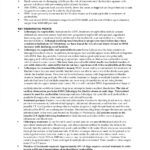
If that cost is not prohibitive to you, these are options that might spare your cat from the traditional surgical methods. The outcome of any procedure this complicated can never be fully predicted, so these specialists are either expert surgeons themselves or have them close at hand.
Should I Consider Those High-tech Procedures For My Cat?
In most cases, a skillful traditional veterinary surgeon can remove urinary tract stones from your pet’s lower urinary tract with similar success to lithotripsy. However, there are cases when the locations of the calculi, there size and consistency or the general health of your cat might make laser or shock-wave lithotripsy the preferable option. Those decisions have to made on a case-by-case basis by the veterinary specialist handling your pet’s case.
What If I Don’t Have These Stones Removed?
Oxalate bladder stones are painful to your pet. And small stones that block its urethra can be fatal. Your veterinarian may be successful in pushing small stones back into the pet’s urinary bladder to gain time. But oxalate bladder stones tend to have rough surfaces that irritate the bladder lining and lead to chronic urinary tract infections. When stones are composed of struvite, you probably have non-surgical options. But when they are composed of oxalate, you do not.
Some veterinary specialists do not always recommend surgery when calcium oxalate stones are located in your pet’s kidneys. They distinguish between those they consider “clinically active” and those they consider “clinically inactive”. In some of those cases you probably do have the option to “manage” the pet – periodically checking it for bacterial infections, discomfort or evidence that the stone(s) are obstructing urine flow. That is particularly true if you pet has multiple health issues or if the stones have returned after a prior surgery.
There is a reason these veterinarians may be reluctant to remove kidney stones. It is because the surgery or procedures necessary to remove them sometimes damages the kidneys themselves. Since so few veterinarians in the World possess those skills and highly specialized equipment, my advice to you is to have radiographs and medical records from your pet sent by your veterinarian to one of the urology centers I mentioned earlier.
When calcium oxalate stones form in a cat’s kidneys, they can eventually damage those organs beyond repair. In those cases, kidney transplants have been used successfully. You can read about that procedure here.
Will My Cat Form New Stones After Surgery?
Luckily, the relapse rate for cats that develop calcium oxalate urinary tract stones is considerably lower than it is for dogs. In a 1998 study, less than 8% had developed stones again within a 4 year period (although a few cats developed new stones on multiple subsequent occasions). You should be able to decrease the chances of relapse even further by concentrating on positive changes in your cat’s lifestyle and diet.
What Type Of Follow-up Visits To My Vet Will Be Required?
If your pet’s calculi were removed surgically, your initial visits will be to be sure the surgery went well and that the pet’s urinary tract allows for the free passage of urine. Your vet will also run tests to be sure the pet is free of infection. X-rays will have been taken when the surgery was completed to be sure all stones were removed. It the pet was treated with lithotripsy, it is not that uncommon for a second lithotripsy to be required to break up residual stone fragments or for other procedures to be used to assist you cat in purging itself from the granular debris.
From then on, the visits will be to access the success of the dietary and lifestyle changes you have made in your pet’s life. Although the veterinarian may check your pet’s blood calcium level, acidity (TCO) or other problems that may have contributed to the problem, the most important periodic examination will be the characteristics of your pet’s urine. Unless the urine is to be cultured for bacteria, there is no need to catheterize the pet – a fresh clean-catch specimen is sufficient.
Your vet will want to do periodic x-rays to see if the stones have returned or if those that could not be removed have moved or grown in size.
Periodic Urinalysis
Your veterinarian will want to analyze your pet’s urine periodically. (urinalysis) (Some veterinarians recommend that as frequently as every two months, indefinitely) The vet will be particularly interested in your pet’s urine pH, urine specific gravity or any indication of blood or infection. The vet will also look at the sediment present in the urine specimen for any signs of oxalate crystals.
The best urine to bring in for testing is the first urine of the day – before your cat has eaten. It should be free of contamination, refrigerated or chilled and brought to the animal hospital as rapidly as possible. I have my clients place a Saran Wrap film over the cat’s litter that morning to collect the sample, a special cat litter for that purpose is also available. You do not need much – a tablespoon- full will do.
Owners who are not health professionals cannot identify crystals or bacteria microscopically. But they should learn to perform some of these simple tests themselves. Owners who perform these simple tests at home are more likely to test their pets frequently and so they are more likely to have better outcomes. You can read the instructions for one popular brand here. You can buy them online or at your local pharmacy. No prescription needed.
What Can I Do To Prevent Oxalate Stones From Reoccurring In My Cat?
No veterinarian has a foolproof plan to guarantee that your cat will not produce oxalate stones again. That is because no veterinarian knows for certain why some cats develop these stones and others do not. What veterinarians can do is use their general knowledge of oxalate chemistry and cat metabolism to accomplish things we think would be helpful in preventing a relapse in your pet:
The Importance Of Water Consumption:
Increased water consumption = dilute urine. From what we know about calcium oxalate, it is very unlikely to crystallize into discrete, urinary tract stones when your pet’s urine is dilute – even if oxalates are present at the time. Healthy cats are not, by nature, big drinkers. But there are several ways that you can increase your cat’s water consumption. They include feeding you cat only canned, frozen or home-cooked diets, moderately increasing the amount of salt in your cat’s diet, and, in carefully chosen cases, administering diuretic medications like hydrochlorothiazide. There is a section on each of those options below. You will only know you are succeeding by measuring the specific gravity of your pet’s urine on multiple occasions.
In addition all cats need easy access to clean, fresh water throughout the day. Multi-cat families should have multiple water bowls.
Your Cat’s Urine Specific Gravity
Because the most important things you can do to prevent urinary stones from reoccurring is to keep your pet well hydrated and it’s urine as dilute as possible, you need to take special care to monitor it. We measure the degree of dilution of urine by its Specific Gravity. The lower the specific gravity, the more dilute the urine sample is. Aim at keeping your pets urine specific gravity below 1.025. Because low specific gravity is so critical, it is safer to measure it with a specific device called a refractometer, rather than to rely on the readings obtained from Multistixs and similar urine dipstick strips.
I encourage all my clients with stone-forming pets to purchase a refractometer. Do not be intimidated by the gizmo’s name or weird construction – it will not bite and it is very easy to use. Once you get the hang of it, your readings will be as accurate as a PhD chemist. Just be sure the instrument has been calibrated to zero with distilled water and that you are reading the specific gravity scale (SP) , not the serum protein (SP) scale. You can read more about urine refractometers and urine specific gravity here.
Your Cat’s Urine pH
Oxalate stones only form in urine that is acidic. We measure acidity by the pH of your cat’s urine. It is normal for cat urine to be acidic (pH less than 7) – cats are carnivores, and all carnivore urine is acidic. Urine that is too basic (pH higher than 7) brings its own set of problems. Most cats that initially come to veterinarians with oxalate stone problems have urine pH of 6.5 or less. If you are fortunate, you will be able to make changes in your pet’s diet that keep its urine pH consistently higher than that. But raising your cats urine pH above that is not always possible. When it isn’t remember that as far as we know, dilute urine trumps less acidic urine. That is, it is more important to keep your cat’s urine dilute than to raise its pH.
Checking your cat’s urine pH is another test you can easily perform at home using urine dipsticks or color-indicator paper. The sample to check is the first fresh void of the morning. Urine pH varies during the day. After your pet has eaten breakfast, its urine pH will begin to rise from its nighttime levels.
Frequent Opportunities to Urinate
Cats need clean, fresh litter boxes available at all times. If you have more than one cat, you need more than one litter box – particularly if one of your critters is prone to urinary tract disease. Social interactions between household cats are not always apparent. One cat or another may be hesitant to use a litter box frequently due to its location or the scent of the previous user. Fewer urinations during the day result in added time that urine remains in the bladder and kidneys which might give more time for stones to develop. You can read about some of the factors that make cats reluctant to visit their litter boxes here.
Frequent Feeding
The acidity (pH) of your cat’s urine fluctuates during the day. It will be lowest during the night, if food is unavailable then, and then probably slowly rises after the pet’s morning meal as it does in dogs (postprandial alkaline tide) but because cats are intermittent nibblers and munchers, not as strikingly. If this will be a new situation for your cat, be sure its total daily food intake does not increase sufficiently for it to become a fatty (obese).
Monitoring Your Cat’s Urine RSS (Relative Supersaturation)
Much of my advice on prevent oxalate urinary tract stones relies on research conducted at the Waltham Centre For Pet Nutrition, located in Waltham-on-the-Wolds, Leicestershire, UK. The Center conducts nutritional research on cats and cats there and funds promising projects elsewhere. Unfortunately I believe that it is now part of the Mars Confectionery Conglomerate/Royal Canin, the makers of Royal Canin, etc., so its independence and focus may be a thing of the past.
In an attempt to predict oxalate stone formation before it occurs, Waltham pioneered the use of relative supersaturation (RSS) testing in pets. RSS testing predicts when conditions in your pet’s urine are conducive to stone formation and when they are not. That is critical information to know, because it allows you to decide if the changes you have made to your pet’s diet and lifestyle are working. If you plan to prepare your cats meals at home, RSS and a standard urinalysis are a good way to see if you are on track. If you feed a commercial canned diet designed to prevent oxalate stones, RSS and urinalysis are a good way to decide which brand is working best for your cat. Although RSS makes sense theoretically, there are no scientific studies to prove it actually works in cats or humans.
Although this is a great test, there is one problem – no US labs that I know of offer it for pets. Quest Diagnostics offers the tests to people who have a calcium oxalate stone problem but their veterinary division does not. You can see what a typical report looks like here. Only physicians can submit samples – perhaps you will have better success in dealing with that than I did.
Periodic Blood Analysis
It is always prudent to run standard blood chemistry panels from time to time. This is especially true when oxalate stones remain in your cat’s kidneys or when there was any prior elevation of blood BUN or creatinine levels.
There are a few cats that develop oxalate stones because their blood calcium levels are abnormally high (hypercalcemia). (read here) Ragdoll cats seem particularly predisposed to this (read here)
Periodic Radiographs
Periodic x-rays are important in detecting new calculi that may form and in judging the growth and position of calculi that have not been removed. When calculi are discovered early, it might be possible to removed them from the bladder through urohydropropulsion or extract them in a retrieval basket through the urethra or through a very small abdominal and bladder incision.
Are There Medications That Might Help?
Potassium Citrate
Veterinarians have traditionally dispensed potassium citrate solutions to cats that have developed oxalate stones. The hope was that when the citrate passed out in the cat’s urine, it would tie up urine calcium making it unavailable for calcium oxalate formation. It was also hoped that the citrate would keep the urine less acidic.
Some studies make it unclear if this theory holds up. Certainly, to have a continuous effect, the potassium citrate would have to be given many times during the day. If not, it would probably be best to give the whole daily dose at bedtime because we suspect that night time conditions are most conducive to stone formation.
Thiazide Diuretics
I mentioned that keeping your cats urine specific gravity under 1.025 was very important in preventing reoccurrence of stones because all forms of urinary tract stones are less likely to form in dilute urine. When you can not achieve that with canned or fresh diets and water supplementation, some veterinarians resort to medications that make your pet thirstier and urinate more. These are the diuretics. The most commonly used non-thiazide diuretic, furosemide, is not used because it is known to increase the calcium content of urine – something we do not want. So some veterinarians give these pets thiazide diuretics. The most common one used for this purpose is hydrochlorothiazide. No medication is without risk. I would not administer diuretics to cats with calcium oxalate problems unless less drastic diet changes and increased fluid intake measures have failed. While on thiazide diuretics, your pets blood electrolytes ought to be monitored.
Table Salt?
One of the simplest ways to increase your cat’s water intake is to slightly increase the saltiness of its food – preferably with salt that contains no iodine. Based on what they had read about human medicine, there was a time that veterinarians thought that doing so would increase the calcium content of urine which might aggravate an oxalate stone problem. But that does not appear to be true in cats. A slightly higher salt diet produced urine was more dilute an less likely to form calcium oxalate stones (based on a lower RSS urine saturation index). You can read about the study done in dogs in the US here and the one in the UK here. Despite those results, recommendations regarding optimal salt content in your pet’s diet remain confusing. read here:
Now we hear everyday that us humans ought not eat salt. And certain people probably should limit their salt intake. But the most recent study in dogs found that a low sodium diet in otherwise healthy dogs might cause more damage than good (read here) and the most recent human study found the same thing in otherwise healthy people. It failed to document any correlation between sodium intake and longevity. (read here)
I can not tell you how much salt to add. But I would certainly add a very moderate amount before I would resort to hydrochlorothiazide diuretic treatment when I could not keep my pet’s urine specific gravity low without it. Another new option is Purina’s new product, Hydra Care™. I always suggest my clients feed their pets human, supermarket food – not cat food. You can read some suggestions here . When you do that, you can taste the food. Broiled roast beef, hamburger or skinless chicken has about 50- 60 mg of salt naturally per 100 grams of meat. There would certainly be no problem if you doubled that amount. (As a reference, canned corned beef has 1,740 mg/100 gm, cheddar cheese 620 mg/100 gm – not that I would give either to a cat !)
Have your pet’s blood pressure, heart and kidney function checked in 2 months and then occasionally if you increase its salt intake significantly. Don’t get carried away – if it tastes too salty for you, it’s too salty for your cat. I would only use a very small amount of non-iodized salt. Keep in mind that your cat’s blood pressure readings tend to be higher in veterinary hospital situations than they actually are at home. Many cats run elevated blood pressures due to stress and fear when brought to animal hospitals – even if they show no outward signs of stress and fear. Read about that here. There is no such thing as a “Fear free” animal hospital.
Will My Cat Need A Special Diet From Now On?
Special diets will not dissolve calcium oxalate stones that have already formed. But cats that have had an episode of calcium oxalate bladder or kidney stones have special needs. They should not be fed dry cat chow again and they should not receive a diet that contains plant products that are high in oxalates.
If you prepare your cat’s diet yourself or feed it considerable foods you yourself eat, there are food ingredients you really should avoid feeding. You can read a list of those foods here.
You can purchase many diets from your veterinarian that were designed, theoretically, to reduce the likelihood of calcium oxalate urinary tract stones. Whether these diets actually work, is unknown. They are all formulated to provide as little dietary oxalate as possible, provide no more than the necessary amount of calcium and attempt to keep your pet’s urine pH and specific gravity in acceptable ranges. If you determine, through urinalysis, that they are doing that, they are fine. If not, they are not fine. These diets are a Godsend for dealing with struvite stones; they are not nearly as effective in managing oxalate stones. So do not let using them lull you into a false sense of security that the problem is solved. You still need to monitor your pet’s urine specific gravity and other parameters of its urinary tract health.
You can also make your pet’s diet at home. The diet you prepare should be made from the same quality ingredients that you eat. That is the only way you will truly control what is going into your pet. It should be based primarily on meats, with the option of adding moderate amounts of low-oxalate low-starch/low sugar vegetables. It needs a source of supplemental vitamins as well as calcium. You can find suggestions in that same article mentioned above. Contrary to what is often written, there is no evidence that protein restriction is beneficial to cats with oxalate problems. You can read a study on that in dogs here. I know of none done for cats. Red meat, chicken and turkey are quite low in oxalate, organ meats, like liver, can be higher because much of the oxalate formed in the body is produced in the liver.
Remember, what you feed is not nearly as important as the effects it has on your cats urine concentration (specific gravity) and pH. There is evidence that some “stone-forming” cats absorb and process dietary ingredients differently than non-stone forming cats. Focus on how diet and lifestyle are effecting your cat’s urine, not just on what it is eating.
Do not feed your cat products that contain soy or yellow corn or ingredients that are derived from soy or corn. Soybean products have the potential to be very high in oxalates. (read here) The same goes for corn and corn-derived products (the amount in feed corn = hard yellow corn appears to be more than in white corn). Many pet foods, both dry and canned, are chocked full of yellow corn products and corn gluten isolates to boost the label’s protein content. Besides being potentially high in oxalates, corn glutens have the potential to make your pet’s urine too acidic. (read here)
Raw diets are not a good idea for pets with oxalate urinary tract stones if they contain vegetable ingredients. Boiling, and discarding the water that was used, greatly reduces the amount of absorbable oxalate in vegetables and grains.
Do not attempt to increase your pet’s water intake by pouring water on dry cat food in hot weather or when the food will stand for more than an hour. Bacterial growth in the mixture can cause digestive upsets. The same goes for leaving canned food at room temperature for long periods.
If I Prepare My Cat’s Diet At Home Should I Restrict It’s Calcium Intake?
That is probably not a good idea. Calcium Oxalate does require free urine calcium to form. So for a long time, both physicians and veterinarians thought that restricting dietary calcium would help prevent oxalate stones. That theory did not hold up. You can ask me for oxalatecat-AbigailsPhDthesis
Why Have The Number Of Oxalate Calculi Risen So Dramatically Over The Last 30 Years?
One reason is probably that the lifestyles of owners and pets have also changed dramatically over the last 30 years. For dogs, there is been a shift to smaller breeds, that appear to be more susceptible to the problem and more owners are working full time and unable to provide spaced intervals for their dogs to urinate and exercise during the day. During the same period, more cat owners keep their pets solely indoors where their activity level tends to also be less and their body weights greater. We know that lack of exercise predisposes humans to calcium oxalate calculi. Perhaps it affects cats similarly.
But there is another reason. It is the pet food industry itself. The last 30 years have seen two important changes in that industry. Conglomeration into a few megafirms that dominate the World pet food market , a worldwide explosion of demand for prepared pet foods and intense competition for limited animal protein resources (meat-based products).
Conglomeration means limited competition and increased focus on profitability. As in all industries , without competition from smaller start-up firms, the incentives to produce quality products decreases. Exploding demand for meat-based products has driven up the price of these ingredients. To maintain profit margins and satisfy investors, these companies have had to search out other sources of protein than meat. The price of plant-source proteins has remained more static over that period. That is why these firms funded an explosion of research attempting to prove that cats would do just as well a major source of the protein in their diets was cheaper plant protein (soy and corn gluten). God created cats as carnivores – meat eaters. You only need to look at their teeth to know that. There were bound to be negative consequences of feeding them primarily plant-based , rather than meat-based diets. I believe that the dramatic increase in the rate of calcium oxalate urinary stones is likely only one of them.
Pet Food Conglomerates are masters at serving up cheap food ingredients wrapped in fancy labels and snazzy TV add campaigns. Let’s look at the ingredients in a popular Nestlé ’s (aka Purina) product, Naturals Cat Chow® From Purina. It’s no better and no worse than the other mass-market cat foods you find at your retailer.
Well, looking at the bag label, it says it contains 38% protein, 13% fat and a maximum of 6% fiber. So going by the NRC guidelines (ref) on feline nutrition, it seems just fine there and in its other essential nutrients. It says it contains real chick and salmon too, its “All Natural” and it shows a big slab of salmon on the bag! By law, cat food ingredients are listed according to their weight in the finished product – the largest ingredient first. You see that its major ingredients are: Chicken meal, corn gluten meal, soybean meal, brewers rice, animal fat , corn meal, chicken, salmon, powdered cellulose, ground whole wheat, soybean hulls, malt extract and brewers dried yeast.
Hmm…. Chicken is listed as the first ingredient – that sounds good. But wait, they broke up the corn analysis and the soybean analysis to keep the chicken in first place on the list and it doesn’t say chicken, it says chicken meal. That is the stuff that was not fit for human consumption, the “4D birds” (dead, dying, diseased or disabled) that got tossed off the processing line for one reason or another. But these companies know that pet owners like to see meat as the first ingredient and there is no USDA rule against this slight-of-hand. The soybeans and corn are actually the primary ingredients that went into the Naturals bag. Salmon is the 8th ingredient and you can bet it wasn’t the tasty slab you see on the package. If the kibble is 13% fat by weight, and that’s the 5th ingredient – can’t be much salmon there. Besides, salmon is 72% water – it would be somewhere South of the cellulose (wood fiber) if all was given on an honest, dry-weight basis.
The soybeans and corn are added solely to make this a high-protein product while still retaining a suitably high-profit margin. There is debate as to whether soy protein is inferior to meat protein. (read here, & here) But there is no debate in that soy products are very high in oxalate.
Brewers rice is a byproduct of human rice cultivation – not something in beer. It is made up of the culled, broken grains resulting from the rice milling industry. (The fragments that pass through a #4 sieve but not a 2.5 sieve). It is added to keep the meat at the front of the ingredient list and the corn products lower down. It also adds starch that manufacturers say they need to form an extruded pellet. Corn gluten meal is a byproduct obtained when corn is processed into ethanol for your car or corn syrup. It is a traditional ingredient in cattle feed. You can read about it here. Gluten has also been associated with increased urinary tract stones in dogs. (read here) Despite what yo see on TV pet food commercials, God created cats to be carnivores. Cats have not experienced as dramatic an increase in oxalate urinary tract stones as dogs have. Interestingly enough, the percentage of animal protein in commercial cat foods has not decreased as dramatically as it has in many dog food brands. The only reason the manufacturers have not put more plant protein in cat food is that most cats wouldn’t eat it if they did. That does not deter some determined folks from attempting to vegetize their cats.
Are There Any Medications My Cat Should Avoid After Developing An Oxalate Stone Problem?
Yes.
Veterinarians would like to keep as much calcium out of your pet’s urine as possible. A common diuretic, Lasix (furosemide) increases the calcium content of urine. Most cats receive it for chronic heart problems. If your cat is a known stone-former, perhaps your vet would consider a thiazide diuretic like chlorthiazide (Diuril®) or hydrochlorothiazide (Hydrodiuril®).
Some cats receive steroid medications for chronic inflammatory conditions. One of the minor side effects of these medications (prednisolone, dexamethasone, etc.) is that they might increase the calcium content of urine and lower urine pH. Some cats have no choice but to receive long-term or intermittent steroids. But any cat that can avoid it with another option, should.
Supplements containing vitamin C, excessive vitamin D or excessive amounts of calcium should probably not be given to cats that have a tendency to form calcium oxalate urinary tract stones.
Diets designed to prevent struvite urinary stones appear to, on occasion, make pets more susceptible to oxalate stones. There was a time when these diets were formulated to produce a markedly acidic urine. When oxalate stones began to increase in frequency, these diets were reformulated to come closer to a neutral pH. Today, it is more likely that cats that develop oxalate stones on those diets just aren’t drinking enough.
Oxalobacter formigenes
In about 1994, human urologists became interested in a fragile bacteria that inhabited the large intestine of humans and many animals. That bacteria, Oxalobacter, was capable of destroying oxalate. In fact, oxalate was what it lived on. One study appeared to indicate that humans with oxalate stone problems were less likely to have this helpful bacteria. The theory was that prior antibiotic use might have killed of the bacteria, making those humans more susceptible to oxalate urinary tract stones. The bacteria is also present in some cats, you can read an article about that here. Whether or not the presence or absence of Oxalobacter plays a part in oxalate calculi formation in humans or cats remains unknown. Some studies suggest it might (read here) and some that it might not. (read here)
It may turn out that some of my suggestion are unnecessary. It may turn out that some are ineffective. But until veterinarians better understand why some cats form calcium oxalate stones on one diet and lifestyle, while others with that same diet and lifestyle do not, this is the best advice I can give you.
You are on the Vetspace animal health website
Visiting the products that you see displayed on this website help pay the cost of keeping these articles on the Internet.

